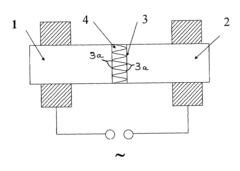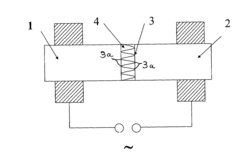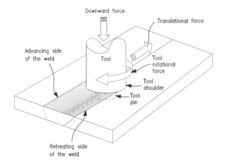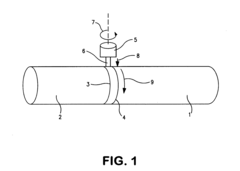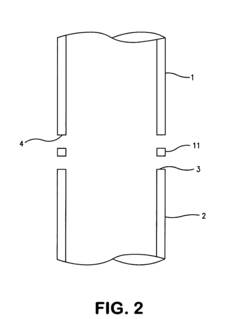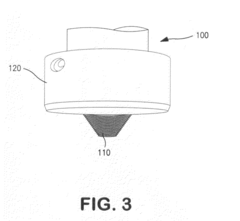Advancements in Butt Welding Technology: A Comprehensive Analysis
MAY 12, 20259 MIN READ
Generate Your Research Report Instantly with AI Agent
Patsnap Eureka helps you evaluate technical feasibility & market potential.
Butt Welding Evolution
Butt welding technology has undergone significant advancements since its inception, evolving from basic manual techniques to sophisticated automated systems. The evolution of butt welding can be traced through several key stages, each marked by technological breakthroughs and improved methodologies. In the early 20th century, butt welding primarily relied on manual processes, with skilled welders using basic equipment to join metal pieces. The introduction of electric arc welding in the 1920s marked a significant leap forward, enabling more precise and efficient welding operations. As industrial demands grew, the 1950s and 1960s saw the development of semi-automated welding systems, which incorporated mechanized feeding of welding wire and improved control over welding parameters. The 1970s and 1980s witnessed the integration of computer-controlled systems, leading to the emergence of fully automated welding processes. This period also saw advancements in welding power sources, with the introduction of inverter-based technology allowing for better control over the welding arc and reduced energy consumption. The 1990s brought about significant improvements in welding consumables, with the development of advanced filler materials and shielding gases that enhanced weld quality and productivity. The turn of the millennium saw the rise of robotic welding systems, which revolutionized the industry by offering unprecedented levels of precision, speed, and consistency. Recent years have seen the integration of artificial intelligence and machine learning algorithms into welding systems, enabling real-time monitoring and adaptive control of welding parameters. Additionally, the advent of additive manufacturing techniques has opened up new possibilities for butt welding in complex geometries and materials. Throughout this evolution, key milestones include the development of pulsed arc welding, friction stir welding, and laser hybrid welding, each offering unique advantages in specific applications. The ongoing trend towards Industry 4.0 and smart manufacturing is driving further innovations in butt welding technology, with a focus on data-driven process optimization, predictive maintenance, and seamless integration with broader manufacturing ecosystems. As we look to the future, emerging technologies such as augmented reality for welder training and assistance, as well as the use of advanced sensors and vision systems for real-time quality control, promise to further enhance the capabilities and efficiency of butt welding processes.
Market Demand Analysis
The global market for butt welding technology has been experiencing significant growth, driven by increasing demand across various industries such as construction, automotive, aerospace, and oil & gas. The market is expected to continue its upward trajectory, with a projected compound annual growth rate (CAGR) of 5.8% from 2021 to 2026. This growth is primarily attributed to the rising need for efficient and reliable joining methods in manufacturing processes, as well as the increasing adoption of automation in welding operations.
In the construction sector, the demand for butt welding technology is particularly strong, especially in the fabrication of large-scale structures such as bridges, pipelines, and high-rise buildings. The automotive industry is another key driver, with the growing trend towards lightweight vehicles necessitating advanced welding techniques for joining dissimilar materials. The aerospace sector is also contributing significantly to market growth, as manufacturers seek to improve the structural integrity and performance of aircraft components through precise welding methods.
The oil and gas industry remains a major consumer of butt welding technology, particularly for pipeline construction and maintenance. As global energy demand continues to rise, the need for efficient and durable welding solutions in this sector is expected to fuel market growth further. Additionally, the renewable energy sector, including wind and solar power industries, is emerging as a promising market for butt welding technology, driven by the increasing installation of large-scale renewable energy infrastructure.
Geographically, Asia-Pacific is anticipated to be the fastest-growing market for butt welding technology, owing to rapid industrialization and infrastructure development in countries like China and India. North America and Europe are also expected to maintain steady growth, driven by technological advancements and the need for replacement of aging infrastructure.
The market is witnessing a shift towards more advanced and automated welding systems, with a growing emphasis on precision, efficiency, and quality control. This trend is reflected in the increasing adoption of robotic welding systems and the integration of artificial intelligence and machine learning technologies in welding processes. Furthermore, there is a rising demand for environmentally friendly welding solutions, driving innovations in energy-efficient welding equipment and processes that minimize emissions and waste.
As industries continue to evolve and face new challenges, the butt welding technology market is expected to adapt and innovate. The development of new materials and the need for joining dissimilar materials are likely to create new opportunities and drive further advancements in welding technology. Overall, the market outlook for butt welding technology remains positive, with sustained growth expected across multiple industries and regions in the coming years.
In the construction sector, the demand for butt welding technology is particularly strong, especially in the fabrication of large-scale structures such as bridges, pipelines, and high-rise buildings. The automotive industry is another key driver, with the growing trend towards lightweight vehicles necessitating advanced welding techniques for joining dissimilar materials. The aerospace sector is also contributing significantly to market growth, as manufacturers seek to improve the structural integrity and performance of aircraft components through precise welding methods.
The oil and gas industry remains a major consumer of butt welding technology, particularly for pipeline construction and maintenance. As global energy demand continues to rise, the need for efficient and durable welding solutions in this sector is expected to fuel market growth further. Additionally, the renewable energy sector, including wind and solar power industries, is emerging as a promising market for butt welding technology, driven by the increasing installation of large-scale renewable energy infrastructure.
Geographically, Asia-Pacific is anticipated to be the fastest-growing market for butt welding technology, owing to rapid industrialization and infrastructure development in countries like China and India. North America and Europe are also expected to maintain steady growth, driven by technological advancements and the need for replacement of aging infrastructure.
The market is witnessing a shift towards more advanced and automated welding systems, with a growing emphasis on precision, efficiency, and quality control. This trend is reflected in the increasing adoption of robotic welding systems and the integration of artificial intelligence and machine learning technologies in welding processes. Furthermore, there is a rising demand for environmentally friendly welding solutions, driving innovations in energy-efficient welding equipment and processes that minimize emissions and waste.
As industries continue to evolve and face new challenges, the butt welding technology market is expected to adapt and innovate. The development of new materials and the need for joining dissimilar materials are likely to create new opportunities and drive further advancements in welding technology. Overall, the market outlook for butt welding technology remains positive, with sustained growth expected across multiple industries and regions in the coming years.
Technical Challenges
Butt welding technology, while widely used in various industries, still faces several significant challenges that hinder its efficiency and reliability. One of the primary technical hurdles is achieving consistent weld quality across different materials and thicknesses. The heat input and distribution during the welding process can vary significantly, leading to potential defects such as incomplete fusion, porosity, or distortion. This is particularly problematic when dealing with high-strength or heat-sensitive materials, where precise control of the heat-affected zone is crucial.
Another major challenge lies in the automation and robotization of butt welding processes. While automated systems have improved productivity, they often struggle with adapting to variations in joint geometry, material properties, and environmental conditions. The development of advanced sensors and real-time monitoring systems to detect and correct weld defects on-the-fly remains an ongoing area of research and development.
The increasing demand for lightweight structures in industries such as aerospace and automotive has introduced new challenges in butt welding dissimilar materials. The differences in thermal properties, melting points, and chemical compositions between these materials can lead to the formation of brittle intermetallic compounds, reducing the overall strength and durability of the weld joint. Overcoming these metallurgical incompatibilities requires innovative approaches in filler material selection, heat input control, and post-weld heat treatment.
Environmental concerns and stringent regulations have also pushed the industry to develop more energy-efficient and environmentally friendly butt welding technologies. Reducing emissions, minimizing waste, and improving energy utilization during the welding process are becoming increasingly important considerations. This has led to research into alternative power sources, such as laser and electron beam welding, which offer higher precision and energy efficiency but come with their own set of technical challenges in terms of equipment cost and operational complexity.
The miniaturization trend in electronics and medical devices has introduced new challenges in micro-butt welding. Achieving high-quality welds at microscopic scales requires extremely precise control of heat input and material flow, as well as specialized equipment and techniques. Additionally, the welding of advanced materials such as high-entropy alloys and metal matrix composites presents unique challenges due to their complex microstructures and properties.
Lastly, the integration of digital technologies and Industry 4.0 concepts into butt welding processes has introduced new technical challenges related to data management, cybersecurity, and interoperability of welding equipment with broader manufacturing systems. Developing robust, secure, and standardized communication protocols for welding equipment and ensuring seamless integration with enterprise resource planning (ERP) and manufacturing execution systems (MES) are ongoing challenges that require interdisciplinary collaboration between welding experts, software engineers, and IT professionals.
Another major challenge lies in the automation and robotization of butt welding processes. While automated systems have improved productivity, they often struggle with adapting to variations in joint geometry, material properties, and environmental conditions. The development of advanced sensors and real-time monitoring systems to detect and correct weld defects on-the-fly remains an ongoing area of research and development.
The increasing demand for lightweight structures in industries such as aerospace and automotive has introduced new challenges in butt welding dissimilar materials. The differences in thermal properties, melting points, and chemical compositions between these materials can lead to the formation of brittle intermetallic compounds, reducing the overall strength and durability of the weld joint. Overcoming these metallurgical incompatibilities requires innovative approaches in filler material selection, heat input control, and post-weld heat treatment.
Environmental concerns and stringent regulations have also pushed the industry to develop more energy-efficient and environmentally friendly butt welding technologies. Reducing emissions, minimizing waste, and improving energy utilization during the welding process are becoming increasingly important considerations. This has led to research into alternative power sources, such as laser and electron beam welding, which offer higher precision and energy efficiency but come with their own set of technical challenges in terms of equipment cost and operational complexity.
The miniaturization trend in electronics and medical devices has introduced new challenges in micro-butt welding. Achieving high-quality welds at microscopic scales requires extremely precise control of heat input and material flow, as well as specialized equipment and techniques. Additionally, the welding of advanced materials such as high-entropy alloys and metal matrix composites presents unique challenges due to their complex microstructures and properties.
Lastly, the integration of digital technologies and Industry 4.0 concepts into butt welding processes has introduced new technical challenges related to data management, cybersecurity, and interoperability of welding equipment with broader manufacturing systems. Developing robust, secure, and standardized communication protocols for welding equipment and ensuring seamless integration with enterprise resource planning (ERP) and manufacturing execution systems (MES) are ongoing challenges that require interdisciplinary collaboration between welding experts, software engineers, and IT professionals.
Current Methodologies
01 Advanced welding techniques
Recent advancements in butt welding technology include the development of new techniques such as laser welding, friction stir welding, and electron beam welding. These methods offer improved precision, faster welding speeds, and better joint quality compared to traditional welding techniques.- Advanced welding techniques: Recent advancements in butt welding technology include the development of new techniques such as laser welding, friction stir welding, and electron beam welding. These methods offer improved precision, faster welding speeds, and better joint quality compared to traditional welding techniques.
- Automated welding systems: The integration of robotics and artificial intelligence in butt welding processes has led to the development of automated welding systems. These systems can perform complex welding tasks with high accuracy and consistency, reducing human error and increasing productivity.
- Improved welding materials: Advancements in metallurgy have resulted in the development of new welding materials and filler metals that offer better strength, corrosion resistance, and compatibility with various base materials. These innovations contribute to stronger and more durable butt welded joints.
- Enhanced monitoring and control systems: Modern butt welding technology incorporates advanced monitoring and control systems that use sensors, real-time data analysis, and feedback mechanisms to ensure optimal welding parameters and quality. These systems can detect and correct welding defects in real-time, improving overall weld quality and reducing rework.
- Environmentally friendly welding processes: Recent advancements in butt welding technology focus on developing more environmentally friendly processes that reduce energy consumption, minimize waste, and decrease harmful emissions. These innovations include the use of eco-friendly shielding gases, energy-efficient power sources, and recycling of welding materials.
02 Automated welding systems
The integration of robotics and artificial intelligence in butt welding processes has led to the development of automated welding systems. These systems can perform complex welding tasks with high accuracy and consistency, reducing human error and increasing productivity.Expand Specific Solutions03 Improved welding materials
Advancements in metallurgy have resulted in the development of new welding materials and filler metals that offer better strength, corrosion resistance, and compatibility with various base metals. These materials contribute to enhanced weld quality and performance in diverse applications.Expand Specific Solutions04 Non-destructive testing methods
The development of advanced non-destructive testing methods, such as ultrasonic testing, radiographic inspection, and phased array technology, has improved the ability to detect and analyze weld defects. These techniques ensure higher quality control and reliability in butt welded joints.Expand Specific Solutions05 Energy-efficient welding processes
Recent advancements focus on developing energy-efficient butt welding processes that reduce power consumption and environmental impact. These include the use of pulsed power sources, optimized shielding gas mixtures, and improved heat management techniques to minimize energy waste during welding operations.Expand Specific Solutions
Industry Leaders
The butt welding technology market is in a mature growth phase, with a global market size expected to reach several billion dollars by 2025. The industry is characterized by intense competition and continuous innovation. Companies like Danieli & C. Officine Meccaniche SpA, POSCO Holdings, Inc., and NIPPON STEEL CORP. are at the forefront of technological advancements, focusing on improving weld quality, efficiency, and automation. The technology's maturity varies across sectors, with automotive and heavy industries leading in adoption. Emerging players such as Strunk Connect Automated Solutions GmbH & Co. KG are introducing novel solutions, while established firms like IHI Corp. and Samsung Heavy Industries Co., Ltd. are investing in R&D to maintain their competitive edge in this evolving market.
POSCO Holdings, Inc.
Technical Solution: POSCO has innovated in butt welding technology with their PosWELD system, specifically designed for thick steel plates used in shipbuilding and offshore structures. This system utilizes a hybrid laser-arc welding process that combines the deep penetration of laser welding with the gap-bridging capability of arc welding. The PosWELD system incorporates adaptive control algorithms that adjust welding parameters in real-time based on joint geometry and material properties, ensuring consistent weld quality even with varying plate thicknesses.
Strengths: High welding speed, deep penetration, and reduced heat-affected zone. Weaknesses: High initial investment and complexity in parameter optimization.
Samsung Heavy Industries Co., Ltd.
Technical Solution: Samsung Heavy Industries has developed a robotic butt welding system for shipbuilding applications. Their technology incorporates advanced vision systems for precise joint tracking and adaptive welding parameter control. The system uses a multi-pass welding technique with optimized heat input for each pass, minimizing distortion in large steel structures. Additionally, they have implemented AI-driven defect detection algorithms that analyze real-time welding data to predict and prevent potential weld defects.
Strengths: High automation level, improved consistency, and reduced labor costs. Weaknesses: Limited flexibility for complex joint geometries and high initial setup costs.
Key Innovations
Method of resistance butt welding
PatentInactiveUS20080135529A1
Innovation
- A shaped metal insert with cavities filled with welding flux is placed between parts, providing a stable electrical contact and uniform heating, with fluxing and alloying elements that shield the weld zone and promote oxide removal through capillary action.
Butt weld and method of making using fusion and friction stir welding
PatentActiveUS20100159265A1
Innovation
- A method combining a fusion root weld with a friction stir weld, where the fusion root weld provides the necessary support for the FSW process without the need for a backing support, allowing for a strong and defect-free butt weld by adjusting the root weld size and geometry to accommodate the FSW tool's forces.
Environmental Impact
As the environmental impact of industrial processes becomes increasingly scrutinized, the butt welding industry is no exception. Recent advancements in butt welding technology have not only improved efficiency and quality but have also made significant strides in reducing environmental footprints. One of the primary environmental concerns in traditional butt welding processes has been the emission of harmful fumes and gases. However, modern techniques have introduced improved ventilation systems and fume extraction technologies that significantly reduce the release of toxic substances into the atmosphere. Additionally, the development of more energy-efficient welding equipment has led to a decrease in power consumption, thereby reducing the overall carbon footprint of welding operations.
Water usage and contamination have also been addressed through innovative cooling systems and waste management practices. Closed-loop cooling systems have been implemented to minimize water consumption, while advanced filtration technologies ensure that any water discharged from the welding process is free from harmful pollutants. Furthermore, the adoption of eco-friendly welding consumables, such as low-fume electrodes and biodegradable flux materials, has contributed to a reduction in hazardous waste generation.
The shift towards automation and robotics in butt welding has not only improved precision and consistency but has also led to more efficient use of materials. This reduction in material waste translates to less environmental impact from raw material extraction and processing. Moreover, the increased durability and longevity of welds produced by advanced techniques mean fewer repairs and replacements, further reducing the long-term environmental impact of welded structures.
In terms of energy sources, the butt welding industry has begun to embrace renewable energy options. Solar-powered welding equipment and the use of hybrid power systems that combine traditional power sources with renewable energy have started to gain traction. These innovations not only reduce the reliance on fossil fuels but also make welding operations more sustainable and environmentally friendly.
Lastly, the development of simulation and modeling software for butt welding processes has allowed for virtual testing and optimization, reducing the need for physical prototypes and minimizing material waste during the research and development phase. This digital approach to welding design and testing represents a significant step towards more sustainable practices in the industry.
As the butt welding technology continues to evolve, it is clear that environmental considerations are playing an increasingly important role in shaping its future. The industry's commitment to reducing its ecological impact while maintaining high standards of quality and efficiency is paving the way for a more sustainable approach to welding practices.
Water usage and contamination have also been addressed through innovative cooling systems and waste management practices. Closed-loop cooling systems have been implemented to minimize water consumption, while advanced filtration technologies ensure that any water discharged from the welding process is free from harmful pollutants. Furthermore, the adoption of eco-friendly welding consumables, such as low-fume electrodes and biodegradable flux materials, has contributed to a reduction in hazardous waste generation.
The shift towards automation and robotics in butt welding has not only improved precision and consistency but has also led to more efficient use of materials. This reduction in material waste translates to less environmental impact from raw material extraction and processing. Moreover, the increased durability and longevity of welds produced by advanced techniques mean fewer repairs and replacements, further reducing the long-term environmental impact of welded structures.
In terms of energy sources, the butt welding industry has begun to embrace renewable energy options. Solar-powered welding equipment and the use of hybrid power systems that combine traditional power sources with renewable energy have started to gain traction. These innovations not only reduce the reliance on fossil fuels but also make welding operations more sustainable and environmentally friendly.
Lastly, the development of simulation and modeling software for butt welding processes has allowed for virtual testing and optimization, reducing the need for physical prototypes and minimizing material waste during the research and development phase. This digital approach to welding design and testing represents a significant step towards more sustainable practices in the industry.
As the butt welding technology continues to evolve, it is clear that environmental considerations are playing an increasingly important role in shaping its future. The industry's commitment to reducing its ecological impact while maintaining high standards of quality and efficiency is paving the way for a more sustainable approach to welding practices.
Quality Assurance
Quality assurance is a critical aspect of butt welding technology, ensuring the integrity and reliability of welded joints. As advancements in this field continue to evolve, so do the methods and techniques for maintaining and verifying weld quality. Modern quality assurance practices in butt welding encompass a range of non-destructive testing (NDT) methods, real-time monitoring systems, and data-driven analysis techniques.
One of the key developments in quality assurance for butt welding is the integration of advanced NDT methods. These include ultrasonic testing (UT), radiographic testing (RT), and phased array ultrasonic testing (PAUT). These techniques allow for thorough inspection of weld joints without compromising their structural integrity. UT and PAUT, in particular, have gained prominence due to their ability to detect internal defects with high precision and provide detailed imaging of weld profiles.
Real-time monitoring systems have also revolutionized quality assurance in butt welding. These systems utilize sensors and advanced algorithms to continuously monitor welding parameters such as temperature, current, voltage, and wire feed speed. By analyzing these parameters in real-time, deviations from optimal welding conditions can be detected and corrected immediately, reducing the likelihood of defects and improving overall weld quality.
Machine learning and artificial intelligence are increasingly being applied to quality assurance in butt welding. These technologies can analyze vast amounts of welding data to identify patterns and predict potential quality issues before they occur. This predictive approach to quality assurance allows for proactive interventions and optimizations in the welding process, leading to higher consistency and fewer defects.
Another significant advancement is the development of automated inspection systems. These systems combine robotics with advanced imaging technologies to perform rapid and accurate inspections of butt welds. Automated systems can cover large areas quickly and consistently, reducing human error and increasing inspection efficiency.
Digital documentation and traceability have also become integral to quality assurance in butt welding. Modern systems allow for the comprehensive recording of welding parameters, inspection results, and material data. This digital trail ensures full traceability of each weld, facilitating quality audits and compliance with industry standards.
As the industry moves towards Industry 4.0 principles, the integration of quality assurance data with broader manufacturing execution systems (MES) and enterprise resource planning (ERP) systems is becoming more common. This integration allows for a holistic approach to quality management, linking welding quality data with overall production metrics and business processes.
One of the key developments in quality assurance for butt welding is the integration of advanced NDT methods. These include ultrasonic testing (UT), radiographic testing (RT), and phased array ultrasonic testing (PAUT). These techniques allow for thorough inspection of weld joints without compromising their structural integrity. UT and PAUT, in particular, have gained prominence due to their ability to detect internal defects with high precision and provide detailed imaging of weld profiles.
Real-time monitoring systems have also revolutionized quality assurance in butt welding. These systems utilize sensors and advanced algorithms to continuously monitor welding parameters such as temperature, current, voltage, and wire feed speed. By analyzing these parameters in real-time, deviations from optimal welding conditions can be detected and corrected immediately, reducing the likelihood of defects and improving overall weld quality.
Machine learning and artificial intelligence are increasingly being applied to quality assurance in butt welding. These technologies can analyze vast amounts of welding data to identify patterns and predict potential quality issues before they occur. This predictive approach to quality assurance allows for proactive interventions and optimizations in the welding process, leading to higher consistency and fewer defects.
Another significant advancement is the development of automated inspection systems. These systems combine robotics with advanced imaging technologies to perform rapid and accurate inspections of butt welds. Automated systems can cover large areas quickly and consistently, reducing human error and increasing inspection efficiency.
Digital documentation and traceability have also become integral to quality assurance in butt welding. Modern systems allow for the comprehensive recording of welding parameters, inspection results, and material data. This digital trail ensures full traceability of each weld, facilitating quality audits and compliance with industry standards.
As the industry moves towards Industry 4.0 principles, the integration of quality assurance data with broader manufacturing execution systems (MES) and enterprise resource planning (ERP) systems is becoming more common. This integration allows for a holistic approach to quality management, linking welding quality data with overall production metrics and business processes.
Unlock deeper insights with Patsnap Eureka Quick Research — get a full tech report to explore trends and direct your research. Try now!
Generate Your Research Report Instantly with AI Agent
Supercharge your innovation with Patsnap Eureka AI Agent Platform!
